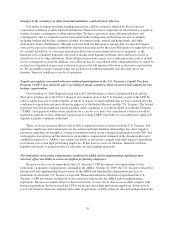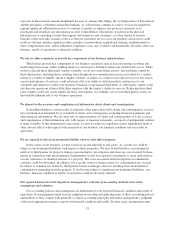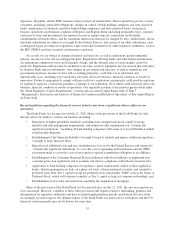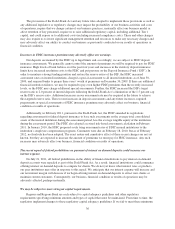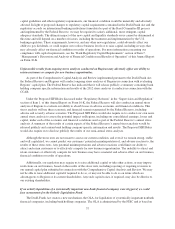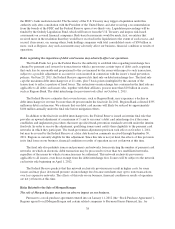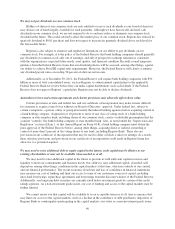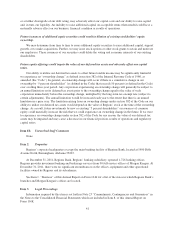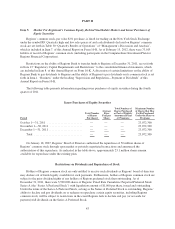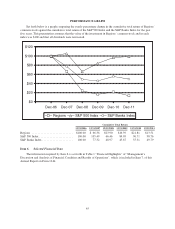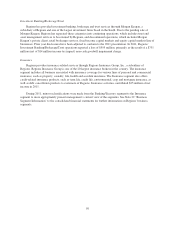Regions Bank 2011 Annual Report Download - page 64
Download and view the complete annual report
Please find page 64 of the 2011 Regions Bank annual report below. You can navigate through the pages in the report by either clicking on the pages listed below, or by using the keyword search tool below to find specific information within the annual report.We may not pay dividends on your common stock.
Holders of shares of our common stock are only entitled to receive such dividends as our board of directors
may declare out of funds legally available for such payments. Although we have historically declared cash
dividends on our common stock, we are not required to do so and may reduce or eliminate our common stock
dividend in the future. This could adversely affect the market price of our common stock. Regions has reduced its
quarterly dividend to $0.01 per share and does not expect to increase its quarterly dividend above such level for
the foreseeable future.
Regions is also subject to statutory and regulatory limitations on our ability to pay dividends on our
common stock. For example, it is the policy of the Federal Reserve that bank holding companies should generally
pay dividends on common stock only out of earnings, and only if prospective earnings retention is consistent
with the organization’s expected future needs, asset quality, and financial condition. Recently issued temporary
guidance from the Federal Reserve states that our dividend policies will be assessed, among other things, against
our ability to achieve Basel III capital ratio requirements. Moreover, the Federal Reserve will closely scrutinize
any dividend payout ratios exceeding 30 percent of after-tax net income.
Additionally, as of December 30, 2011, the Federal Reserve will require bank holding companies with $50
billion or more of total consolidated assets, such as Regions, to submit annual capital plans to the applicable
Federal Reserve Bank for review before they can make capital distributions such as dividends. If the Federal
Reserve does not approve Regions’ capital plan, Regions may not be able to declare dividends.
Anti-takeover laws and certain agreements and charter provisions may adversely affect share value.
Certain provisions of state and federal law and our certificate of incorporation may make it more difficult
for someone to acquire control of us without our Board of Directors’ approval. Under federal law, subject to
certain exemptions, a person, entity or group must notify the federal banking agencies before acquiring control of
a bank holding company. Acquisition of 10 percent or more of any class of voting stock of a bank holding
company or state member bank, including shares of our common stock, creates a rebuttable presumption that the
acquirer “controls” the bank holding company or state member bank. Also, as noted under the “Supervision and
Regulation” section of Item 1. of this Annual Report on Form 10-K, a bank holding company must obtain the
prior approval of the Federal Reserve before, among other things, acquiring direct or indirect ownership or
control of more than 5 percent of the voting shares of any bank, including Regions Bank. There also are
provisions in our certificate of incorporation that may be used to delay or block a takeover attempt. As a result,
these statutory provisions and provisions in our certificate of incorporation could result in Regions being less
attractive to a potential acquirer.
We may need to raise additional debt or equity capital in the future; such capital may be dilutive to our
existing shareholders or may not be available when needed or at all.
We may need to raise additional capital in the future to provide us with sufficient capital resources and
liquidity to meet our commitments and business needs. Our ability to raise additional capital, if needed, will
depend on, among other things, conditions in the capital markets at that time, which are outside of our control,
and our financial performance. The recent economic slowdown and loss of confidence in financial institutions
may increase our cost of funding and limit our access to some of our customary sources of capital, including
inter-bank borrowings, repurchase agreements and borrowings from the discount window of the Federal Reserve.
Additionally, our long-term debt securities are currently rated below investment grade by certain of the credit
ratings agencies. As a non-investment grade issuer, our cost of funding and access to the capital markets may be
further limited.
We cannot assure you that capital will be available to us on acceptable terms or at all. Any occurrence that
may limit our access to the capital markets, such as a decline in the confidence of debt purchasers, depositors of
Regions Bank or counterparties participating in the capital markets, our status as a non-investment grade issuer,
40


